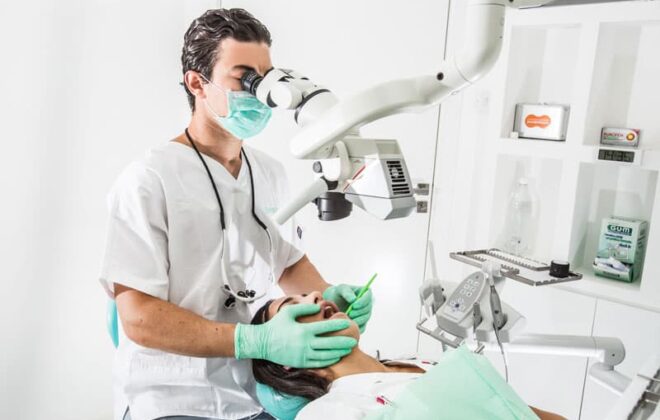The Myth of Root Canals
Do you know what’s going on inside your teeth? I had never even contemplated the matter until April, when one of my molars began its revolt and my teeth became the only things I was capable of contemplating. As anyone who’s been in this position knows, the quaint discomfort that the word toothache implies doesn’t capture the incredible misery that a toothache can produce; sometimes, the pain was so bad that I found it difficult to use my laptop.
After a week’s worth of inconclusive X-rays, a futile round of antibiotics, and fistfuls of an ibuprofen-acetaminophen cocktail recommended by the internet, I was finally shuffled to an endodontist—a specialist who treats dental pain—to confront my tormenter. I had cracked a tooth, which the endodontist was finally able to locate with a CT scan. Moments later, I was being shot up with novocaine, and after a few minutes of drilling, the endodontist asked me if I wanted to see the source of all my agony. “Yeth,” I said, mostly through my nose. He held up his forceps, and dangling from the end was what looked like a tiny, leaf-bare tree rendered in the vivid red of fresh blood. It looked too perfect, its edges too discrete, like something created for a movie instead of an ordinary blob of human viscera.
Nothing about this was going how I’d expected. When a tooth cracks, the oft-recommended treatment is one of the most commonly feared procedures in modern medicine: a root canal, so famously terrible that its name has long been a popular metaphor for a lengthy tour through agony itself. That’s what I was in the chair for that day—to have my tooth drilled open and its nerves and vasculature scooped out. After the CT scan, I’d pleaded with the specialist to root-canal me right then and there, while I was feeling the bravery of absolute desperation, instead of making me come back the next day. That’s when things got weird. The procedure was fast, and it was painless enough for me to make noises of surprised approval upon sight of the newly removed chunk of my face. When the endodontist told me we were all finished, I thought he might be joking—pop culture had spent years steeling me for an experience that apparently no longer existed. A few hours later, once the local anesthetic had worn off, I ate dinner like nothing had happened.
My story is a not-uncommon one from the past year and a half. Through some combination of intense stress, new medication, and what had previously been a mild predisposition toward grinding my teeth in my sleep, I joined lots of other Americans in what seems to be a pandemic tooth-cracking bonanza. According to a February survey by the American Dental Association, almost two-thirds of dentists reported seeing more cracked teeth in their practices during the pandemic than before it, and 71 percent reported higher rates of bruxism, which is the involuntary grinding that can lead to cracks. My endodontist said as much: The root-canal business was booming.
Asgeir Sigurdsson, the chair of the NYU Department of Endodontics, told me that that’s still the case, six months after my procedure. Not only are people stressed, but many people whose problems would have been spotted during a routine visit in 2020 skipped their checkups, for financial reasons or because of a fear of COVID-19 infection. Then, as Americans began getting vaccinated, dentists’ appointment books began to fill up quickly, which may have helped further dissuade some patients from getting a cleaning on the calendar.
Checkups are easy to put off—even the most basic dental care is expensive and, at best, physically uncomfortable, and about a third of American adults don’t have insurance that covers any part of it. Submitting to a cleaning opens up the possibility that you’ll be told that you need an expensive, painful procedure, and there are some unscrupulous practitioners who take advantage of patients’ inability to evaluate their own oral health.
People who need a root canal tend to know they need it, or know they need something. Cracks, infections, and severe decay make themselves apparent in no uncertain terms. Teeth are extremely sensitive; each tooth has 1,500 to 2,000 nerve fibers at its core, according to Sigurdsson, and most of them are a type of receptor that only feels pain. (If you’ve never considered the total absence of tooth pleasure from your life, well, there you go.) It’s perhaps not surprising, then, that at some point in the not-too-distant past, getting all of those nerve fibers scooped out of your tooth really hurt—enough to create an understanding of the root canal that has endured far beyond its own accuracy. Thank God for advances in medicine and technology.
Except that when it comes to root canals, there haven’t been many significant advances. Sigurdsson has been performing the procedure regularly for 30 years, and it’s basically the same now as when he learned it in dental school. “What I think has changed maybe more is the way we teach our students to approach it,” he said. “To have more empathy for your patient, wait until the anesthesia has truly kicked in, and then give additional anesthetics if needed.” If you got a root canal a couple of decades ago and the pain scarred you for life, it probably didn’t have to—your dentist or endodontist might just have been an old-school rub-some-dirt-on-it type who didn’t really care if it did.
None of this means that every single patient’s procedure now is pain-free, even if everything is done correctly. The novocaine injections are themselves pretty uncomfortable, and can be terrifying for patients who fear needles. Some patients with additional complications, such as severe nerve inflammation, won’t fully respond to the available anesthetics, Sigurdsson noted. And some evidence suggests that people with intense anxiety about their procedure are more difficult to anesthetize, maybe because their fight-or-flight response or some other neurochemical reaction inhibits the anesthetic’s effectiveness. But, Sigurdsson promised me, the majority of his patients are “pleasantly surprised.”
If decades of dental students have been taught to fully numb their root-canal patients instead of diving right into their pulp, then why does the procedure’s reputation persevere? It might be because, for most people, root canals are mercifully rare. Many people who will need more than one in their lifetime go decades between procedures, unaware that their next one won’t be so bad. For people who’ve never had a root canal, they may remember their parents complaining about a particularly bad one.
Or millions of people may have been misled simply by growing up in the 1990s. According to Google Ngram, which tracks the popularity of words in books and newspapers over time, the phrase was particularly omnipresent in media during that decade. Joking about root canals does fit in with the what’s-the-deal-with-airplane-food comedy of the era; an episode of Seinfeld even features the specter of Jerry’s future root canal and the procedure’s seriousness as a reason he fights with Elaine. But as better-trained dentists enter the field and more people have uncomfortable but uneventful root canals, the same Google data show that the procedure’s ability to strike fear in our hearts, at least metaphorically, may be waning. The comedians of the 2020s will have to find a different way to tell you how comparatively agonizing it is to go to the DMV.
Article originally appeared at: https://www.theatlantic.com/
Author: Amanda Mull



